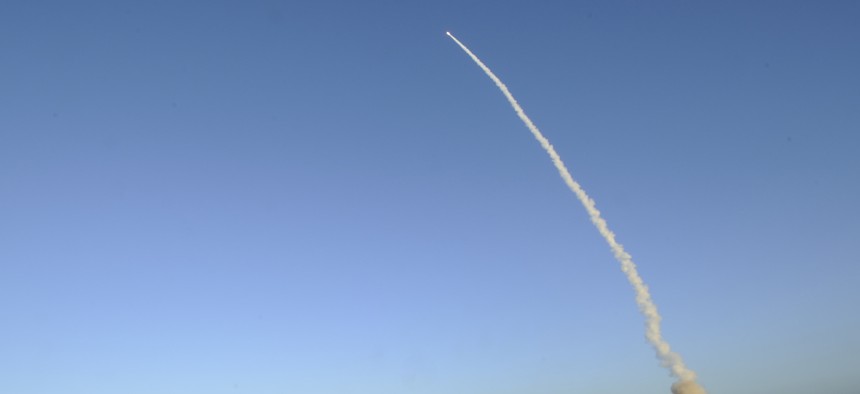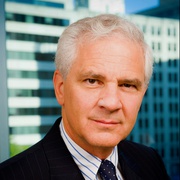
An unarmed LGM-30G Minuteman III intercontinental ballistic missile launches during an operational test at Launch Facility-4 on Vandenberg Air Force Base, Calif., in 2014. U.S. Air Force / Senior Airman Lael Huss
The Biggest Nuclear Threats of 2018 Will Follow Us into the New Year
We whistled past the graveyard this year. Let’s be smarter in 2019.
There was some positive news this year — most importantly the decreased possibility of war in Korea — but, overall it was bleak. Let’s get right to it.
1. The New Nuclear Arms Race is the clear winner as the greatest global nuclear threat of 2018. Each of the nine nuclear-armed states is building new weapons and the United States, instead of strengthening the global nuclear safety net, is actively shredding it.
In March, Russian President Vladimir Putin announced five new nuclear weapons he said Russia was building in response to the U.S. decision to abrogate the Anti-Ballistic Missile treaty. All are designed to circumvent defenses. Russia has also deployed a small number of ground-based cruise missiles whose range exceed that permitted by the Intermediate Nuclear Forces (INF) Treaty that President Ronald Reagan negotiated. In October, President Donald Trump said he would pull out of this arms elimination pact, despite the objections of NATO allies.
Destruction of the INF Treaty is likely a prelude to allowing the New START treaty to die. This pact, negotiated by President Barack Obama, limits long-range strategic forces. If both go, it will be the first time since 1972 that U.S. and Russian nuclear forces have been completely unconstrained.
“The untimely death of these two agreements would add fuel to a new arms race and further undermine stability and predictability between Washington and Moscow,” warned former National Security Council senior director Jon Wolfsthal.
In mid-December, 26 Democratic senators wrote Trump “out of deep concern that your administration is now abandoning generations of bipartisan U.S. leadership.” They feared that Trump and his administration wanted “to double down on new, unnecessary nuclear weapons while scraping mutually beneficial treaties.” This, they said, “risks the United States sliding into another arms race with Russia and erodes U.S. nonproliferation efforts around the world.”
Some countries, perhaps many of them, may see the building of new arsenals and the killing of restraining treaties as a material breach of the U.S. and Russian pledges in the nuclear Non-Proliferation Treaty, up for review in 2020. “Today, pessimism about the future of the nuclear nonproliferation regime is again on the rise,” writes Harvard professor Rebecca Davis Gibbons. More countries, armed with more nuclear weapons would likely encourage greater risk-taking, leading to more conventional conflicts and the great risks of escalation.
2. President Trump remains a unique global nuclear threat. The danger comes from the combination of his nuclear policies, his ability to command the launch of a nuclear weapon at anytime, for any reason, and his intensifying domestic political crises.
Any president in this period would face the problems of restraining nuclear-armed adversaries, maintaining a U.S. nuclear deterrent, and rolling back the nuclear programs in North Korea and Iran. But Trump’s policies have made several of these problems worse. His Nuclear Posture Review would build new, and more usable, nuclear weapons at a price tag of almost $2 trillion while abandoning any effort to restrain global arsenals. This not only fuels an arms race, it breaks the deal with the Senate that “investments in the U.S. nuclear weapons deterrent...must be accompanied by pursuit of continued arms control measures,” as the 26 senators wrote.
Serious concerns about Trump’s mental stability have raised serious questions about the wisdom of a system that gives the president sole, unchecked authority to launch America’s nuclear weapons. Trump’s January 2018 tweet warning to North Korean leader Kim Jong-un “that I too have a Nuclear Button, but it is a much bigger & more powerful one than his, and my Button works!” sparked bipartisan worries.
“Spoken like a petulant ten year old,” said Eliot Cohen, political scientist and professor at Johns Hopkins School of Advanced International Studies.
“No one person should have the power to decide when the U.S. will be the first to use nuclear weapons,” said Sen. Ed Markey, D-Mass..
In the new year, multiple investigations will increase the pressure on Trump. “If the Mueller report implicates Trump or his family,” Keith Mestrich of Amalgamated Bank told journalist Bill Press, “who knows what he will do?” During his impeachment crisis, President Richard Nixon brought the nuclear alert level up to DefCon 3, just short of the alert level during the Cuban Missile Crisis. Trump could do worse.
3. War with Iran is not an immediate nuclear risk, but starting a new, larger war in an already chaotic region would lead quickly to new nuclear programs. Iran would undoubtedly restart and expand its program (now effectively frozen by the 2015 anti-nuclear deal). Saudi Arabia has already pledged to match Iran’s efforts. New nuclear-armed states would appear alongside Israel in the region within the coming decade.
This threat ranks ahead of North Korea because unlike Northeast Asia, where there are no U.S. allies who want to go to war, the Middle East features Saudi Arabia under Mohammed bin Salman and Israel under Benjamin Netanyahu, who may seek to provoke military conflict with Iran.
President Trump seems reluctant to start new wars, but John Bolton and Mike Pompeo are orchestrating a “maximum pressure” campaign and staffing up the State and Defense Departments with Iran war hawks. Our European allies oppose this campaign, say the administration has failed to build a coalition against Iran, and worry it will lead to military escalation.
As domestic difficulties increase for the leaders of Israel, Saudi Arabia, and America, one or more of them could be tempted to distract critics and rally the public with a war crisis. The Persian Gulf was in 2018 and will remain in 2019 the area of the world most likely to see a new war, with profound nuclear consequences.
Related podcast:
4. North Korea holds both promise and peril. After a tumultuous January that raised fears of nuclear war, the Olympic peace effort of South Korean President Moon Jae-in succeeded, lowering tensions and opening up a diplomatic path. Trump’s surprise acceptance in March of North Korean President Kim Jong-un’s meeting offer led to a bizarre Singapore summit. But the joint efforts have dramatically lowered the risk of war on the peninsula and provide the glimmer of a diplomatic resolution.
North Korea is the one area of the world where Trump could secure a foreign policy victory. “While it is welcome that we are moving away from a warpath,” 38 North editor Jenny Town concluded, “the jury is still out on whether the Trump administration has the political will and prowess to sustain this process and actually take the negotiation past broad commitments to implementable measures.”
If Trump strikes a partial deal at the planned 2019 summit with Kim, he could establish a step-by-step process that could advance security assurances to North Korea and begin suspension and dismantlement of its nuclear infrastructure. It will be partial, and uncertain, but it will give Moon what he needs to advance stabilization efforts on the peninsula.
Trump could stumble, or be undermined by those in his own administration, like Bolton and Pompeo, who insist on North Korea’s complete disarmament before any U.S. reciprocal steps. Congressional Democrats have demonstrated knee-jerk opposition to Trump’s diplomacy. They could continue to criticize any deal as too weak, hoping to get to the right of him on a national security issue. Or critics could be proven correct, that North Korea has no intention of negotiating even a partial denuclearization deal.
Some or all of these obstacles could destroy the diplomatic path in 2019. “At this point, the risks of a war will probably start rising again,” warns Carnegie Endowment expert James Acton. “Once diplomacy has been tried and ‘failed,’ what else is left?” Any spark could set off a military conflict that could quickly go nuclear.
5. South Asia is the sleeper nuclear catastrophe. Tensions between India and Pakistan eased in 2018. The Council on Foreign Relations lowered the risk of conflict to “low” in its annual Preventive Priorities Survey.
But the impact of a conflict here remains the highest of any region in the world. A war between the two nations would almost certainly quickly go nuclear, kill tens of millions, trigger global economic chaos, and have catastrophic global consequences.
Pakistan and India have the fastest growing nuclear forces in the world. Both have about 150 nuclear weapons, are building more, are building more production plants for plutonium and highly enriched uranium for the cores of weapons, and are deploying “battlefield” system
Scientists, using new, more advanced climate models, have updated previous estimates of the “nuclear winter” effect. They now believe that as few as 100 atomic bombs of the type deployed in South Asia, exploded in the dense urban centers of that subcontinent, would put enough soot and particulates in the atmosphere to surround the globe with clouds, lowering global temperatures by 2 to 3 degrees for several years. This would kill a large portion of the world’s food crops. Over one billion people would die in the resulting famine. The resulting migrations and struggles of the survivors would threaten all of human civilization.
All of these nuclear risks are serious. Some are world-ending. None are receiving the attention they deserve. In 2018, we whistled past the nuclear graveyard. We have to hope that we will be smarter in 2019.
NEXT STORY: The Kurds Have Been Betrayed Again by Washington




